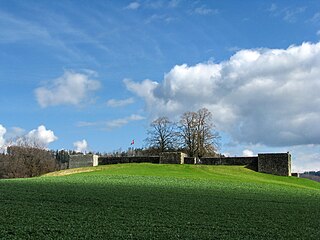 W
WThe Roman fort at Weissenburg, called Biriciana in ancient times, is a former Roman Ala castellum, which is a UNESCO World Heritage Site located near the Upper Germanic-Rhaetian Limes. It lies in the borough of Weißenburg in the Middle Franconian county of Weißenburg-Gunzenhausen in Germany. Today the castellum is one of the most important sites of research in the Roman limes in Germany. The site contains partly subterranean building remains, a reconstructed north gateway, large thermal baths and a Roman Museum with an integrated Limes Information Centre.
 W
WThe Danube–Iller–Rhine Limes or DIRL was a large-scale defensive system of the Roman Empire that was built after the project for the Upper Germanic-Rhaetian Limes in the late 3rd century AD. In a narrower sense the term refers only to the fortifications between Lake Constance and the River Danube (Danubius); in a broader sense it also includes the other Late Roman fortifications along the river Rhine (Rhenus) on the High Rhine(between Lake Constance and Basle) and on the Upper Rhine as well as the Upper Danube.
 W
WIrgenhausen Castrum is a Roman fort at Irgenhausen, situated on Pfäffikersee lake shore in Switzerland. It was a square fort, measuring 60 metres (197 ft) in square, with four corner towers and three additional towers. The remains of a stone wall in the interior were probably a spa.
 W
WThe Limesfall is the name given to the abandonment of the Upper Germanic-Rhaetian Limes in the mid-3rd century AD by the Romans and the withdrawal of imperial troops from the provinces on the far side of the rivers Rhine and Danube to the line of those rivers. It is sometimes called the fall of the limes.
 W
WMerano or Meran is a city and comune in South Tyrol, northern Italy. Generally best known for its spa resorts, it is located within a basin, surrounded by mountains standing up to 3,335 metres above sea level, at the entrance to the Passeier Valley and the Vinschgau.
 W
WPassau is a town in Lower Bavaria, Germany, also known as the Dreiflüssestadt because the Danube is joined there by the Inn from the south and the Ilz from the north.
 W
WRegensburg is a city in south-east Germany, at the confluence of the Danube, Naab and Regen rivers. With more than 150,000 inhabitants, Regensburg is the fourth-largest city in the State of Bavaria after Munich, Nuremberg and Augsburg. The city is the political, economic and cultural centre and capital of the Upper Palatinate. During portions of the Holy Roman Empire rule it housed the Perpetual Diet of Regensburg.
 W
WThe Upper Germanic-Rhaetian Limes, or ORL, is a 550-kilometre-long section of the former external frontier of the Roman Empire between the rivers Rhine and Danube. It runs from Rheinbrohl to Eining on the Danube. The Upper Germanic-Rhaetian Limes is an archaeological site and, since 2005, a UNESCO World Heritage Site. Together with the Lower Germanic Limes it forms part of the Limes Germanicus.
 W
WVindonissa was a Roman legion camp, vicus and later a bishop's seat at modern Windisch, Switzerland. The remains of the camp are listed as a heritage site of national significance. The city of Brugg hosts a small Roman museum, displaying finds from the legion camp.